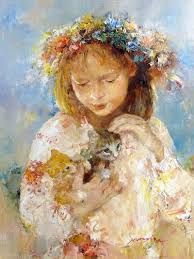tempera
ABOUT AQUARIAN PAINTING TECHNIQUE (part 4)
 But with the beginning of the technical revolution, with the advent of industrial methods for the manufacture of materials, broader opportunities arose for creative experiments and the popularization of watercolor painting.
But with the beginning of the technical revolution, with the advent of industrial methods for the manufacture of materials, broader opportunities arose for creative experiments and the popularization of watercolor painting.
Newer and cheaper materials have made this technique fragile and more vulnerable to storage. Perhaps that is why for a long time watercolor still remained an independent form of painting and was the lot of fans of plein air painting as a particularly delicate aesthetic pleasure obtained during outdoor recreation.
The perception of watercolors was often associated with the idea of some very simple, affordable and even frivolous way of painting, more suitable for the initial stage of training, preceding the training in oil technology. Continue reading




